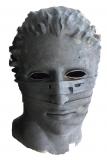Results 1 to 7 of 7
Thread: 3d benchy need help
-
01-07-2016, 04:30 PM #1Student

- Join Date
- May 2015
- Posts
- 43
3d benchy need help
12507681_206325339712208_9205043744837559209_n.jpg12509051_206325296378879_617221640050743789_n.jpg12510483_206325319712210_5319534002229340974_n.jpg
Need help finding out why my prints turn out like this. first layers turn out nice then it starts to warp. I am printing on a non heated bed pla. It is sticking good. I have tried temps from 210-225.
object infill: 13
layer height:.2
number of shells:1
feedrate: 70
Travel feedrate:65
Thanks
-
01-08-2016, 01:03 AM #2Engineer-in-Training

- Join Date
- Sep 2014
- Location
- Brummen, Netherlands
- Posts
- 265
My 2 cents worth: The PLA is not cooling enough to stay rigid when the next layer is being put down, therfore the nozzle+viscous_pla is tugging on the still rubbery lower layer. The first layers profit from the release of heat to the bed (extra cooling), the higher layers don't.
Try lowering feedrate to 40, temp to 190-210 range (or even down to 180 at 40 mm/s feedrate). A minimum of 2 shells also may help as these are put down at a slower rate and support each other.
-
01-08-2016, 01:56 AM #3
What he says. 225°C is too hot for PLA.
-
01-08-2016, 06:12 AM #4Student

- Join Date
- May 2015
- Posts
- 43
Thanks guys. I had it down to 210 but I'll try lowering it more. It looks like the nozzle is bumping into a tiny Hill from where it started its first layer
-
01-08-2016, 10:48 PM #5Student

- Join Date
- May 2015
- Posts
- 43
-
01-08-2016, 11:12 PM #6Student

- Join Date
- May 2015
- Posts
- 43
here is a video just skip to 28 seconds in. that is what keeps happening
https://www.youtube.com/watch?v=e3-usFYDLxw
-
01-09-2016, 03:55 AM #7Engineer-in-Training

- Join Date
- Sep 2014
- Location
- Brummen, Netherlands
- Posts
- 265
1) First of all you can see that the plastic is rubbery and flexing when the nozzle passes over it -> the plastic does not cool off enough before the next layer is put on. The part you are printing is small and there are just seconds before a new layer is put on. If the plastic has solidified enough, it won't flex due to the dragging force of the nozzle laying down more plastic and you get good parts.
The object is to get the plastic too cool more. Either a special cooling fan which is directed at the nozzle tip can be used,or you need to have a minimum time between layers. S3D allows you to specify the minimum time for a layer and the nozzle will coast beside the object until that time has been met before doing the next layer. If your slicer can do that I don't know, you will have to search the settings.
2) Another less likely additional cause is that you are extruding too much plastic. Check the diameter of your roll of filament with calipers. Also be aware that PLA needs some amount of under-extrusion. In S3D this extrusion factor is 90%, that is 10% less plastic is being extruded than should be according to calculations. Other slicers will at least let you adjust the diameter of your filament to decrease (increase filament diameter) or increase (decrease filament diameter). Example: if your current filament setting (D) is 1.75mm and you want to decrease the extruded by 10% you need to trick the slicer into thinking that it is extruding the correct amount. Thus the new filament diameter setting is Dnew = sqrt(1.1 *D*D) = 1.8354mm. This way the exruder will extrude 10% less, similar to the 90% extrusion factor setting in S3D.
3) The final even less likely possibility is that your z-steps are not correct in the firmware. That is that the actual vertical movement is less than what the firmware expects. This will only occur if the firmware is not the correct one for your printer hardware or some hardware belts/pulleys have been changed.
Having said 2) and 3), your video demonstrates with absolute certainty that the plastic is not cooling enough and you should solve that problem first.
You can try ABS which does not need a cooling fan and my guess is that the part will print fine then. Cooling is a major issue with PLA as its glass point is around 65 C (ABS has a glass point around 105 C). The glass point of a polymer is the temperature above which it becomes flexible (rubbery). The melting point where it becomes a viscous liquid is much higher, but for opposing the dragging forces you need to cool below the glass point.




 Reply With Quote
Reply With Quote





Extruder not feeding during print,...
Yesterday, 02:02 PM in Tips, Tricks and Tech Help